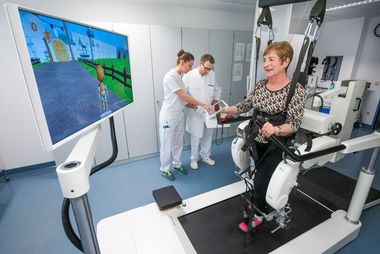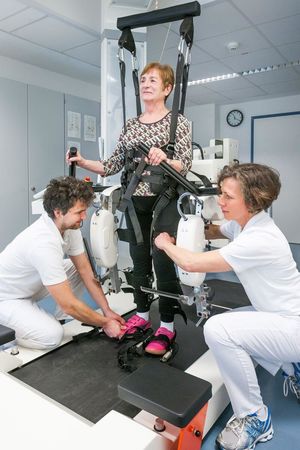'Locomat' helps patients learn to walk again

August 2016
The Spinal Cord Injury Center puts the latest gait robot into operation. New features improve the early therapy for incomplete spinal cord lesions.
At first glance, this looks like a common video game, but it is an important building block in the early treatment of an incomplete spinal cord injury. Patients must walk along a street in a virtual world, while avoiding hindrances and collecting coins. However, this avatar is not moved with a joystick or a console, but interactively through the patient’s own leg movements in a special gait robot on a treadmill – a difficult task for paraplegics who can barely move their legs anymore. The Spinal Cord Injury Center at Heidelberg University Hospital has now put this latest generation gait into operation.
Robot-assisted treadmill therapy has already helped paralyzed patients at Heidelberg for about 15 years to walk again. Now the latest model has replaced the old robot. “The new gait robot can do much more than the old one: It simulates the natural flow of movement much better, can be adjusted more precisely to patients and provides detailed feedback on the progress of training” says Professor Norbert Weidner, Medical Director of the Spinal Cord Injury Center at Heidelberg University Hospital. “Moreover, the games encourage active participation – it does not really help the patient if the robot does all of the work.” The costs of this new training device developed in Switzerland amounts to about 380,000 euros.

The robot does what the patient is unable to accomplish on his own
“You can only learn to walk by walking,” says Anne von Reumont, Head of Physiotherapy and Physical Therapy at the Center for Orthopedics, Trauma Surgery and Spinal Cord Injuries at Heidelberg University Hospital. For this reason, patients should begin with gait therapy as soon as possible after the injury. The gait robot is in use at an early phase of rehabilitation, as soon as patients are able to sit for a longer period, which in most cases takes one to two weeks. The prerequisite is that the nerve connections to the legs have not been completely interrupted. No matter how sophisticated, training cannot rectify complete paraplegia.
With Locomat therapy, the robot’s computer-aided electric motors are attached to the patient’s legs. Like an exoskeleton, they stabilize patients up to the hips. A strap attached to a suspension device over the treadmill provides the necessary weight relief and security, so that patients can concentrate fully on their leg movements. Therapists can individually adjust to what degree the robot will help patients to walk: Whatever the patient cannot do yet, e.g., adequately lift his leg or move it forward, will be done by the robot. This allows a fluid gait despite all of the restrictions caused by the paralysis. So that this is possible, sensors constantly record the exertion and the independent movements of the patient. Depending on his progress during training, robotic support can be reduced as can the weight relief. “Such a targeted treatment which captures, promotes, and extends the still existing residual movements down to the smallest detail would not be possible or too time-consuming solely with physiotherapy and classic treadmill training supported by up to three therapists,” according to the graduate physiotherapist.
In order to continue to improve the recovery of the ability to walk, there is so-called biofeedback – movement tasks in the form of games of various degrees of difficulty: Patients look at a virtual landscape on a monitor, through which they must navigate during gait training. “Patients remain alert and learn in a playful way to control their leg movements better”, explains Weidner. We hope to achieve a better outcome so that patients can walk with fewer aids and move safely in their everyday lives.” As soon as no robotic leg guidance is needed anymore, simple treadmill training with weight relief is used; followed by walking between the bars. One thing is very important to Weidner and von Reumont: Despite intelligent technical features, the gait robot remains only one building block of a well-conceived and individually adapted therapy concept.
Further information:
Heidelberg University Hospital’s Spinal Cord Injury Center at the Department of Orthopedics

